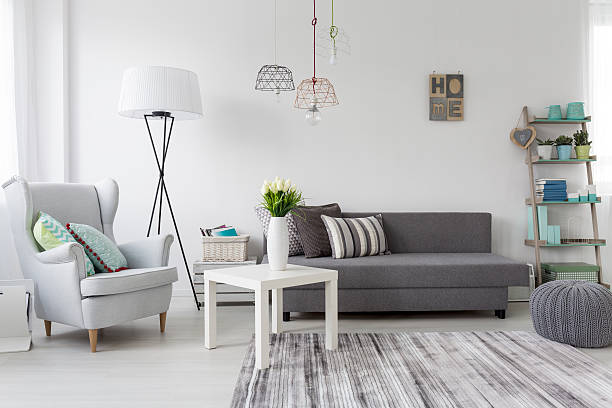Decorating a small living room presents a unique set of challenges and opportunities. Limited space requires a thoughtful approach to ensure the room feels open, functional, and stylish. With the right strategies, you can maximize the potential of a small living room and make it a welcoming and comfortable area for both relaxation and entertaining.
This blog post offers practical and creative decorating ideas tailored to small living rooms to help you transform your cozy space into a functional and stylish haven.

Embrace Light Colors
Paint and Wallpaper:
Light colors can make a small living room feel larger and more open. Consider painting the walls in soft shades of white, cream, or pastel tones. Light colors reflect more light, which can make the space feel airy and expansive. If you prefer wallpaper, opt for light, neutral patterns or textures that don’t overwhelm the space.
Furniture and Decor:
Incorporate light-colored furniture and accessories to maintain a cohesive look. Choose light wood finishes or white and beige upholstery for sofas and chairs. This creates a seamless flow and prevents the room from feeling cluttered.
Optimize Furniture Arrangement
Multi-Functional Pieces:
Invest in furniture that serves multiple purposes. A sofa bed or a pull-out couch can provide extra sleeping space for guests without taking up additional room. Ottomans with storage compartments can help keep clutter at bay while providing extra seating.
Scale and Proportion:
Choose furniture that fits the scale of your living room. Avoid oversized pieces that can overwhelm the space. Instead, opt for compact, sleek furniture with slender profiles. Modular furniture can be customized to fit your layout and needs.
Strategic Arrangement:
Arrange furniture to maximize floor space and facilitate flow. Place larger pieces against walls to open up the center of the room. Use floating furniture arrangements, such as a sofa facing away from the wall, to create a more dynamic and functional layout.
Utilize Vertical Space
Shelving and Storage:
Incorporate wall-mounted shelves and vertical storage units to free up floor space. Floating shelves can hold books, plants, and decorative items while keeping surfaces clear. Tall bookshelves can provide ample storage without taking up too much floor area.
Vertical Decor:
Hang artwork and mirrors higher on the walls to draw the eye upward. This creates the illusion of higher ceilings and makes the room feel more expansive. Choose pieces that are proportionate to the wall space to avoid overwhelming the room.
Incorporate Mirrors
Visual Expansion:
Mirrors are a powerful tool for making a small living room appear larger. They reflect light and create the illusion of depth. Place a large mirror on one wall to enhance the sense of space. Alternatively, use a collection of smaller mirrors to create a focal point and add visual interest.
Decorative Frames:
Select mirrors with decorative frames that complement your decor style. This adds a stylish element while providing functionality. Mirrors with metallic or ornate frames can also serve as statement pieces in the room.
Focus on Lighting
Layered Lighting:
Use a combination of lighting sources to create a warm and inviting atmosphere. Incorporate ambient lighting with ceiling fixtures or recessed lights. Add task lighting with table lamps or floor lamps for reading and other activities. Use accent lighting to highlight artwork or architectural features.
Reflective Surfaces:
Incorporate reflective surfaces like glass, chrome, or metallic finishes in your decor. These surfaces can bounce light around the room, making it feel brighter and more spacious. Consider reflective coffee tables or decorative accessories to enhance the effect.
Use Rugs to Define Spaces
Area Rugs:
Rugs can help define different areas within a small living room. Use an area rug to anchor the seating area and create a sense of cohesion. Choose rugs with patterns or colors that complement your decor while adding visual interest.
Size and Placement:
Select rugs that are appropriately sized for your space. A rug that is too small can make the room feel disconnected, while a rug that is too large can overwhelm the area. Ensure that the rug fits comfortably within the boundaries of your furniture arrangement.
Opt for Minimalistic Decor
Declutter:
A cluttered space can feel cramped and disorganized. Keep decor minimal and purposeful. Choose a few key decorative items that enhance the room’s aesthetic without overcrowding the space. Use decorative storage boxes or baskets to keep small items neatly organized.
Simple Lines and Shapes:
Select decor and furniture with clean lines and simple shapes. Avoid overly ornate or bulky items that can make the room feel smaller. Minimalistic decor creates a streamlined look that enhances the sense of space.
Add Vertical Stripes and Patterns
Wall Treatments:
Vertical stripes on walls can create the illusion of height, making the room feel taller. Use subtle stripes or patterns in light colors to maintain an open and airy feel. Avoid heavy patterns that can make the space feel cluttered.
Textures and Layers:
Incorporate different textures to add depth without overwhelming the room. Use textured throw pillows, blankets, or rugs to add interest. Layering textures adds dimension and makes the space feel more inviting.
Incorporate Greenery
Indoor Plants:
Plants add a touch of nature and freshness to any room. Choose compact, low-maintenance indoor plants like succulents, snake plants, or pothos that fit well in smaller spaces. Use hanging planters or wall-mounted pots to save floor space.
Plant Stands:
Use plant stands or tiered plant shelves to display greenery without taking up too much space. This adds a vertical element to your decor while showcasing your plants in an attractive and space-efficient manner.
Personalize with Accessories
Artwork and Photos:
Add personal touches with artwork or family photos. Create a gallery wall with framed prints, paintings, or photos that reflect your personality and style. Arrange the pieces in a cohesive layout to add visual interest without overwhelming the room.
Statement Pieces:
Incorporate one or two statement pieces to add character to the room. This could be a unique lamp, an eye-catching piece of art, or a stylish piece of furniture. Statement pieces can serve as focal points and enhance the room’s overall aesthetic.
Conclusion
Decorating a small living room requires a thoughtful approach to maximize space and create a stylish and functional environment. By embracing light colors, optimizing furniture arrangement, utilizing vertical space, and incorporating mirrors and layered lighting, you can make your small living room feel more open and inviting.
Focus on minimalistic decor, use rugs to define spaces, and add personal touches to create a room that reflects your personality and meets your needs. With these decorating ideas, you can transform your cozy living room into a stylish haven where you can relax and entertain in comfort.



